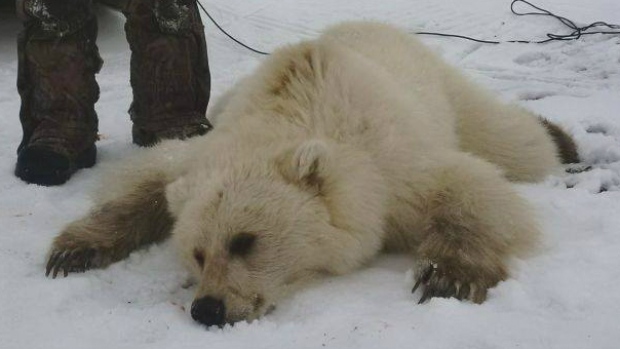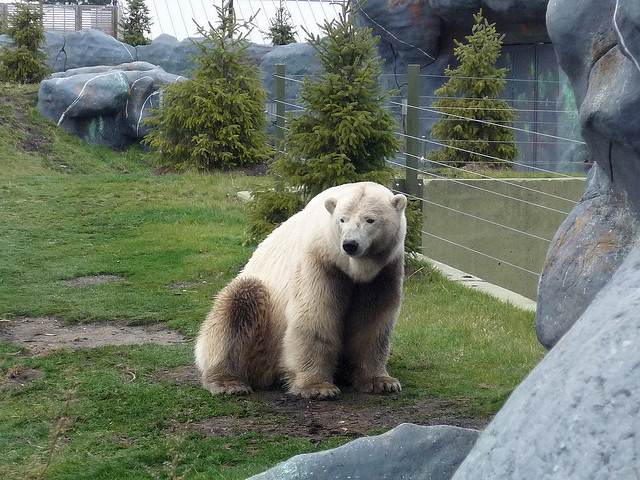It looks like you're using an Ad Blocker.
Please white-list or disable AboveTopSecret.com in your ad-blocking tool.
Thank you.
Some features of ATS will be disabled while you continue to use an ad-blocker.
share:
I was tempted to name this article "Jungle Fever Between Polar Bears and Grizzly Bears." Then I thought "can it be considered Jungle fever when
this is dealing with animals to begin with?" I don't know but nature knows how to surprise us with new and interesting......uh.....combinations..!
Grizzly Bears and Polar Bears? I wonder what could be next?
The article goes on to say that there is no pure breed of animal; not even humans as some of our DNA comes from Neaderthals. As the environment warms it's bringing Bears closer and other pairs of other species closer together with their biological cousins.....What's to say that some of the animals on the Earth presently are not hybrids of past animals which may be extinct now?
I always had this crazy idea that humans are combinations of different plants and/or animals. I think this is interesting.....What says ATS?
www.washingtonpost.com...
BARROW, Ala. — Most Alaskans and Canadians have a bear story — tales of fearsome grizzlies, even polar bears. But a mix of the two? They’re known as pizzlies or grolars, and they’re a fusion of the Arctic white bear and their brown cousins. It’s a blend that’s been turning up more and more in parts of Alaska and Western Canada. Last week, a strange-looking bear was shot by a hunter in Nunavut, a remote territory that curves around Canada’s Hudson Bay. Its head was large, like a grizzly’s, but its fur was white. The bear’s genetics were not tested, but Arctic researchers seem unified in their analysis: It’s a polar-grizzly mix. A hybrid. Textbooks say these two species aren’t supposed to inhabit the same environments. Polar bears are marine mammals; grizzlies are terrestrial. But as the Arctic warms, sea ice is shrinking and the tundra is expanding. And the bears’ disparate populations are meeting, mating and creating a new breed that’s capable of reproducing.
The article goes on to say that there is no pure breed of animal; not even humans as some of our DNA comes from Neaderthals. As the environment warms it's bringing Bears closer and other pairs of other species closer together with their biological cousins.....What's to say that some of the animals on the Earth presently are not hybrids of past animals which may be extinct now?
I always had this crazy idea that humans are combinations of different plants and/or animals. I think this is interesting.....What says ATS?
www.washingtonpost.com...
Actually,...BEST to just call him 'Sir.'
...or "The LAST thing I ever saw".
...or "The LAST thing I ever saw".
edit on 23-5-2016 by IAMTAT because: (no reason given)
It is said that the Polar bear actually origin from the Grizzly bear some 200.000 years ago during an ice age, so they are going back to their
origin.
originally posted by: lostbook
The article goes on to say that there is no pure breed of animal; not even humans as some of our DNA comes from Neaderthals. As the environment warms it's bringing Bears closer and other pairs of other species closer together with their biological cousins.....What's to say that some of the animals on the Earth presently are not hybrids of past animals which may be extinct now?
I always had this crazy idea that humans are combinations of different plants and/or animals. I think this is interesting.....What says ATS?
Humans, just like the rest of the lifeforms on this planet follow the rules of evolution, so yes, humans are made up of different plants and animals. Just like everything else. Humans share 50% dna with a banana tree for instance.
a reply to: lostbook
It seems we could take a lesson from Mother Nature and realize that focusing our efforts on reversing climate change is likely futile and we should be looking into how to adapt to new and changing climates. We see the oceans having problems with coral reef bleaching, and all of the sudden, we have new coral reefs forming at the mouth of a river where such things never used to happen. Yep, it seems Nature isn't going to wait around for us to decide which political views best adhere to the climate.
It seems we could take a lesson from Mother Nature and realize that focusing our efforts on reversing climate change is likely futile and we should be looking into how to adapt to new and changing climates. We see the oceans having problems with coral reef bleaching, and all of the sudden, we have new coral reefs forming at the mouth of a river where such things never used to happen. Yep, it seems Nature isn't going to wait around for us to decide which political views best adhere to the climate.
a reply to: network dude
A problem I see with this is that nature adaptation is slow and haphazard. Human achievement is focused and fast. I wonder how nature can adapt to this...
A problem I see with this is that nature adaptation is slow and haphazard. Human achievement is focused and fast. I wonder how nature can adapt to this...
originally posted by: Krazysh0t
a reply to: network dude
A problem I see with this is that nature adaptation is slow and haphazard. Human achievement is focused and fast. I wonder how nature can adapt to this...
Not nearly as fast as their political views...
Y'all missed one.
LMAO!!
Lots more East than Barrow AK. Instead of worrying about Grizzly's moving north I'd be worried about the Polar Bears moving further south. Or the 1/2's running around further south.

www.cbc.ca...
LMAO!!
Lots more East than Barrow AK. Instead of worrying about Grizzly's moving north I'd be worried about the Polar Bears moving further south. Or the 1/2's running around further south.

Grashelis said polar bears and grizzly bears have similar genetics and have a history of interbreeding. He believes that interbreeding is happening more frequently due to climate change.
Dave Garshelis
Dave Garshelis, a research scientist with the Minnesota Department of Natural Resources, is one of the world's foremost bear experts. (submitted by Dave Garshelis)
"With climate change, grizzly bears are moving further north, so there is more overlap between grizzly bears and polar bears in terms of their range," Garshelis said.
"There are even American black bears that are moving further north. And a few black bears have been spotted outside of Arviat."
Grashelis said a hybrid bear is unofficially called a grolar bear if the sire is a grizzly bear and a pizzly bear if the sire is a polar bear. A third potential name is nanurlak — a word combining the Inuit-language words for polar bear and grizzly, nanuk and aklak.
www.cbc.ca...
The Barren Ground Grizzly's have been around a long time above the tree-line.
pubs.aina.ucalgary.ca...
pubs.aina.ucalgary.ca...
So, can we call these hybrids Biracial Bears...? Actually, that kinda sounds like a good name for a rock band...!
edit on 23-5-2016 by
lostbook because: word add
a reply to: lostbook
The bears are attempting to adapt to "changes in the climate" in order to naturally preserve their genetic relevance on this planet.
(would humans genetically interconnect with beings that were compatible, to preserve genetic survival)?
It appears beings find this as a plausible response to habitat changes and or failures...
OUTTA BOX - It would not be odd to 1 if its found similar activities go on throughout Existence, with even the intelligent aware CREATOR Creations that may exist (considering DNA extraction and additions) in order to preserve or upgrade genetics for further Cosmic survival...
The bears are attempting to adapt to "changes in the climate" in order to naturally preserve their genetic relevance on this planet.
(would humans genetically interconnect with beings that were compatible, to preserve genetic survival)?
It appears beings find this as a plausible response to habitat changes and or failures...
OUTTA BOX - It would not be odd to 1 if its found similar activities go on throughout Existence, with even the intelligent aware CREATOR Creations that may exist (considering DNA extraction and additions) in order to preserve or upgrade genetics for further Cosmic survival...
Fantastic..now if we can just have them breed with a shark and a flamethrower, we got the world eater.
But main question is not answered, are they mating because Polar bears are coming to Grizzlies territory or Grizzlies are coming to polar bears
territory?
Is it because it get warmed or cooler?
What is so interesting in white bear having sex with black bear? Every day white people mate with black people and vice versa and nobody is coming off, or maybe someone is.
Is it because it get warmed or cooler?
What is so interesting in white bear having sex with black bear? Every day white people mate with black people and vice versa and nobody is coming off, or maybe someone is.
a reply to: saadad
They are two different types of bears, due to habitat. Polars are mostly aquatic and their diet reflects that. Grizzlys are land animals. The warming is shrinking the polars habitat and also allowing other animals from warmer climes to go further north.
They are two different types of bears, due to habitat. Polars are mostly aquatic and their diet reflects that. Grizzlys are land animals. The warming is shrinking the polars habitat and also allowing other animals from warmer climes to go further north.
a reply to: Krazysh0t
Nature can always adapt, but you're right - not fast enough for what's coming
No food or water = no time
A problem I see with this is that nature adaptation is slow and haphazard. Human achievement is focused and fast. I wonder how nature can adapt to this...
Nature can always adapt, but you're right - not fast enough for what's coming
No food or water = no time
new topics
-
Joe Rogan conspiracy (maybe)
ATS Skunk Works: 2 hours ago -
Results of the use of the Oreshnik missile system in Dnepropetrovsk
World War Three: 5 hours ago -
Nigel Farage now the Most Favoured UK Politician
Regional Politics: 6 hours ago
top topics
-
Little Johnny and Larry should team up
General Chit Chat: 12 hours ago, 10 flags -
Results of the use of the Oreshnik missile system in Dnepropetrovsk
World War Three: 5 hours ago, 10 flags -
Nigel Farage now the Most Favoured UK Politician
Regional Politics: 6 hours ago, 3 flags -
Will Us use alien technology to fight in ww3?
World War Three: 13 hours ago, 2 flags -
Joe Rogan conspiracy (maybe)
ATS Skunk Works: 2 hours ago, 2 flags
active topics
-
Results of the use of the Oreshnik missile system in Dnepropetrovsk
World War Three • 128 • : WeMustCare -
President-Elect DONALD TRUMP's 2nd-Term Administration Takes Shape.
Political Ideology • 240 • : WeMustCare -
Nigel Farage now the Most Favoured UK Politician
Regional Politics • 6 • : angelchemuel -
President-Elect TRUMP Picks Former Florida A.G. PAM BONDI to be U.S. Attorney General.
2024 Elections • 56 • : VariedcodeSole -
Well we know Putins ICBMs won't fail in their silos
World War Three • 209 • : Xtrozero -
Jaguar Rebrand Video Causes "WTF?" Moment - Seriously Weird
Automotive Discussion • 26 • : angelchemuel -
Post A Funny (T&C Friendly) Pic Part IV: The LOL awakens!
General Chit Chat • 7815 • : baddmove -
Joe Rogan conspiracy (maybe)
ATS Skunk Works • 2 • : watchitburn -
Little Johnny and Larry should team up
General Chit Chat • 3 • : bluesman023 -
Will Us use alien technology to fight in ww3?
World War Three • 11 • : BeyondKnowledge3

